View in other NatureServe Network Field Guides
NatureServe
Montana
Utah
Wyoming
Idaho
Wisconsin
British Columbia
South Carolina
Yukon
California
New York
Watershield - Brasenia schreberi
State Rank Reason (see State Rank above)
Restricted in Montana to shallow waters in the valleys of the northwest corner of the state where it is known from eight occurrences, including six relatively high quality populations. Potential threats to the species include boating activity, aquatic weeds, and several populations are subject to runoff from adjacent agricultural fields, though it is uncertain if this has negatively impacted any populations.
General Description
Watershield is a rhizomatous perennial aquatic herb with branches which rise through the water, floating leafblades (lily pads), and emergent flowers. The leaves have long petioles attached alternately to the branches and centrally to the undersides of the floating leaf blades. The broadly elliptic to oval leaf blades are 4-12 cm long and 3-8 cm wide. Solitary flowers are held just above the water on long peduncles. The flowers usually have 3 sepals and 3 petals which are similar, translucent reddish-purple colored, linear to lance-shaped, and 1-1.5 cm long. There are 4-14 pistils and 12-36 purplish stamens which are about the same length as the petals and sepals. The leathery, beaked fruits are 6-8 mm long and mature underwater.
Phenology
Flowering in August.
Diagnostic Characteristics
Distinguished from other water lilies (Nuphar and Nymphea) by its relatively small, purplish, many pistilled flowers and by its relatively small, truly peltate (with petiole attached to the center of the blade) leaves.
Species Range
Montana Range
Range Descriptions
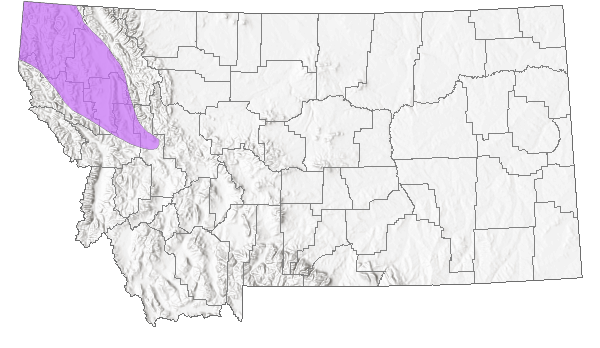
 Native
Native
Range Comments
Most of North America, widespread in other parts of the world except Europe. Sparse.
Observations in Montana Natural Heritage Program Database
Number of Observations: 97
(Click on the following maps and charts to see full sized version)
Map Help and Descriptions
Relative Density
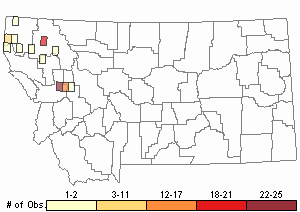
Recency
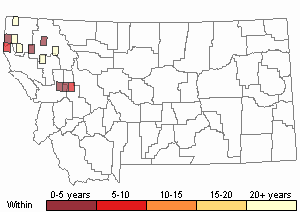
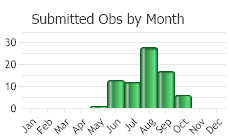
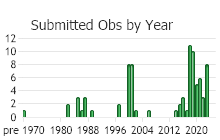
 (Observations spanning multiple months or years are excluded from time charts)
(Observations spanning multiple months or years are excluded from time charts)
Habitat
Shallow water of lakes, sloughs, and slow-moving rivers in the valley zone.
National Vegetation Classification System Groups Associated with this Species
Stewardship Responsibility
Threats or Limiting Factors
STATE THREAT SCORE REASON
Reported threats to Montana’s populations of Watershield are currently assigned as unknown. Motorboat recreation likely threatens plants or populations where they occur at some lakes, but the locations where this threat is relevant is not known (MTNHP Threat Assessment 2021). Information on the scope of this threat is needed to assess its relative risk to Watershield populations.
References
- Literature Cited AboveLegend:
 View Online Publication
View Online Publication MTNHP Threat Assessment. 2021. State Threat Score Assignment and Assessment of Reported Threats from 2006 to 2021 for State-listed Vascular Plants. Botany Program, Montana Natural Heritage Program, Helena, Montana.
MTNHP Threat Assessment. 2021. State Threat Score Assignment and Assessment of Reported Threats from 2006 to 2021 for State-listed Vascular Plants. Botany Program, Montana Natural Heritage Program, Helena, Montana.
- Additional ReferencesLegend:
 View Online Publication
View Online Publication
Do you know of a citation we're missing? Frodge, J. D., Thomas, G. L. and G. B. Pauley. 1990. Effects of canopy formation by floating and submergent aquatic macrophytes on the water quality of two shallow Pacific Northwest lakes. Aquatic Botany 38:231-248.
Frodge, J. D., Thomas, G. L. and G. B. Pauley. 1990. Effects of canopy formation by floating and submergent aquatic macrophytes on the water quality of two shallow Pacific Northwest lakes. Aquatic Botany 38:231-248. Lesica, P., M.T. Lavin, and P.F. Stickney. 2012. Manual of Montana Vascular Plants. Fort Worth, TX: BRIT Press. viii + 771 p.
Lesica, P., M.T. Lavin, and P.F. Stickney. 2012. Manual of Montana Vascular Plants. Fort Worth, TX: BRIT Press. viii + 771 p. Lesica, P., M.T. Lavin, and P.F. Stickney. 2022. Manual of Montana Vascular Plants, Second Edition. Fort Worth, TX: BRIT Press. viii + 779 p.
Lesica, P., M.T. Lavin, and P.F. Stickney. 2022. Manual of Montana Vascular Plants, Second Edition. Fort Worth, TX: BRIT Press. viii + 779 p. Raymond, M., and P. Dansereau. 1953. The geographical distribution of the bipolar Nymphaeaceae, Nymphaea tetragona, and Brasenia schreberi. Memoires du Jardin Botanique de Montreal 41: 1-10.
Raymond, M., and P. Dansereau. 1953. The geographical distribution of the bipolar Nymphaeaceae, Nymphaea tetragona, and Brasenia schreberi. Memoires du Jardin Botanique de Montreal 41: 1-10.
- Web Search Engines for Articles on "Watershield"





